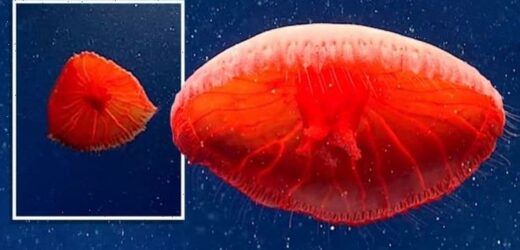Jellyfish: Possible new species discovered by diving team
We use your sign-up to provide content in ways you’ve consented to and to improve our understanding of you. This may include adverts from us and 3rd parties based on our understanding. You can unsubscribe at any time. More info
The unexpected encounter took place at a depth of about 2,300ft (700m) just off the US East Coast. If the researchers are correct, the flan-like creature is a species previously unknown to science. The seas and oceans cover 70 percent of the planet’s surface and yet they remain one of its darkest, unexplored frontiers.
It is estimated anywhere between a few hundred thousand to more than 10 million unidentified species are waiting to be found – but scientists are making slow progress.
The blood-red jellyfish was discovered during an expedition led by the US National Oceanic and Atmospheric Administration (NOAA).
The creature, which resembles an upturned paella dish, most likely belongs to the genus Poralia.
To date, scientists have only ever discovered one other member of the genus, the Poralia rufescens.


The deep-sea creature features a similarly striking red colour to its newly-discovered cousin but is more bell-like in shape with 30 trailing tentacles.
The new species was spotted off the coast of Newport, Rhode Island, on July 28 this year by NOAA’s remotely operated Deep Discoverer.
As the machine dove to the dark depths of the Atlantic – about 3,000ft (915m) – it filmed the various creatures it passed on the way down.
Quinn Girasek, a NOAA intern at the Juniata College in Pennsylvania, explained: “Overall, a variety of animals were seen, like ctenophores, cnidarians, crustaceans, and Actinopterygii (ray-finned fishes).
“We also saw several undescribed families and potentially new species.”
Cornwall: Large jellyfish spotted off St Austell Bay
During the dives, the remotely operated vehicle, or ROV, used a robotic arm with a “suction sampler” to pluck some of the creatures into collection jars.
Ms Girasek said: “That was definitely a highlight and I can’t wait until we learn more about those organisms!”
The mission was carried out as part of NOAA’s North Atlantic Stepping Stones expedition.
Between June 30 and July 29, NOAA conducted 25 dives to depths between 820ft to 13,124ft (250m to 4,000m) to study the Atlantic’s mysterious deep-sea environment.


Earlier in July NOAA shared a viral image of a pink starfish resting on a rock next to a puffy yellow sponge – a discovery that pleased fans of the kids’ cartoon, Spongebob Squarepants.
Ms Girasek said: “It was great to get to know the experts through the science chat room. Everyone was friendly and funny.
“I personally enjoyed the Olympics-related jokes and the excitement about the new jellyfish.
“I truly enjoyed my time with NOAA Ocean Exploration and will never forget this amazing opportunity.
“I am very grateful for everyone who supported me thus far.”
There is no telling just how many species live in our oceans and how many are waiting to be found.
Many species are being discovered every single year, which has helped scientists put some estimates on what else is waiting to be found.
In an article penned for The Conversation, marine biologists from three different universities said: “Most undiscovered creatures likely remain in the least explored habitats such as the deep oceans, the most diverse environments such as tropical shallow seas, and the most diverse groups including molluscs and crustaceans.”
However, most of these species likely range in size from just one millimetre to 10cm – seabed-dwelling crustaceans, molluscs and worms.
Source: Read Full Article


